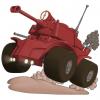We really need to be careful when comparing "One main designer" and "Design by committee" results, and compare apples to apples. If you compare the work of a skilled, experienced, and highly successful designer to that what a group of kindergartners on excessive sugar and coffee come up with, then you're not going to have a very fair time and get a rather biased outcome, much like you would if you sat a group of seasoned designers down and compared their work with that of a single sugar and caffeine pumped kid.
Another important factor when gauging the skill of a designer is whether or not they've worked within the project budget - And that is not just a cash value thing, but also a skill issue. What are the overall skills of the team and what are they actually able to achieve? You can have the most graceful and flawless mechanic and visual designs ever planned, but they're not worth much if the team you're working with doesn't have the skills and resources to do everything to spec by launch day.
And of course there is the wonderful issue of design complexity, and confusing it for quality: A more detailed and more complex design is not a sign of it being superior, it is a sign of it being more detailed and complex. A mechanical power transfer mechanism with a million intermeshed pieces all working together to transfer rotational energy from a motor to some manner of tool is "Extremely detailed and complex", but odds are it is vastly inferior to a handful of suitably designed gears/cogs.
You can run the maths and calculate out all the gravitational forces in the entire solar system to get a "Perfectly accurate simulation" of where every grain of dust will be over the next 10 years, but if all you really wanted was "Where abouts would Mars be..." then you've wasted a lot of time and effort on details that simply didn't matter.
A huge part of a game designer's job, whether we're talking about computer or board games, is distilling out the essence of the design and using the parts that are actually needed while discarding those that are merely distractions, and doing so in a way that is readily understood and enjoyed by the player. And when it comes to board games this can become an exercise in information presentation.
The last version of RISK rules I read were a great example of "Close, but no cigar" design presentation. I'm specifically thinking of the reinforcement mechanic rules, which frankly were a mess. (Trying to relearn a game's rules when you have a 10 year old hopped up on sugar interrupting and insisting they 'know the rules' is a 'fun' holiday experience.) The information could have been far clearer if done in a more point form format with a small table, but instead they give some long and slightly awkward paragraphs describing the mechanic in a general sense that also ends up burying the minimum reinforcement rate somewhere.
- At the very least you should start off a rule's section with what the minimum standard of what a player should expect every turn, and then expand on it from there.
![]() ... we have had way to many confusing thread about that in the past.
... we have had way to many confusing thread about that in the past. 









